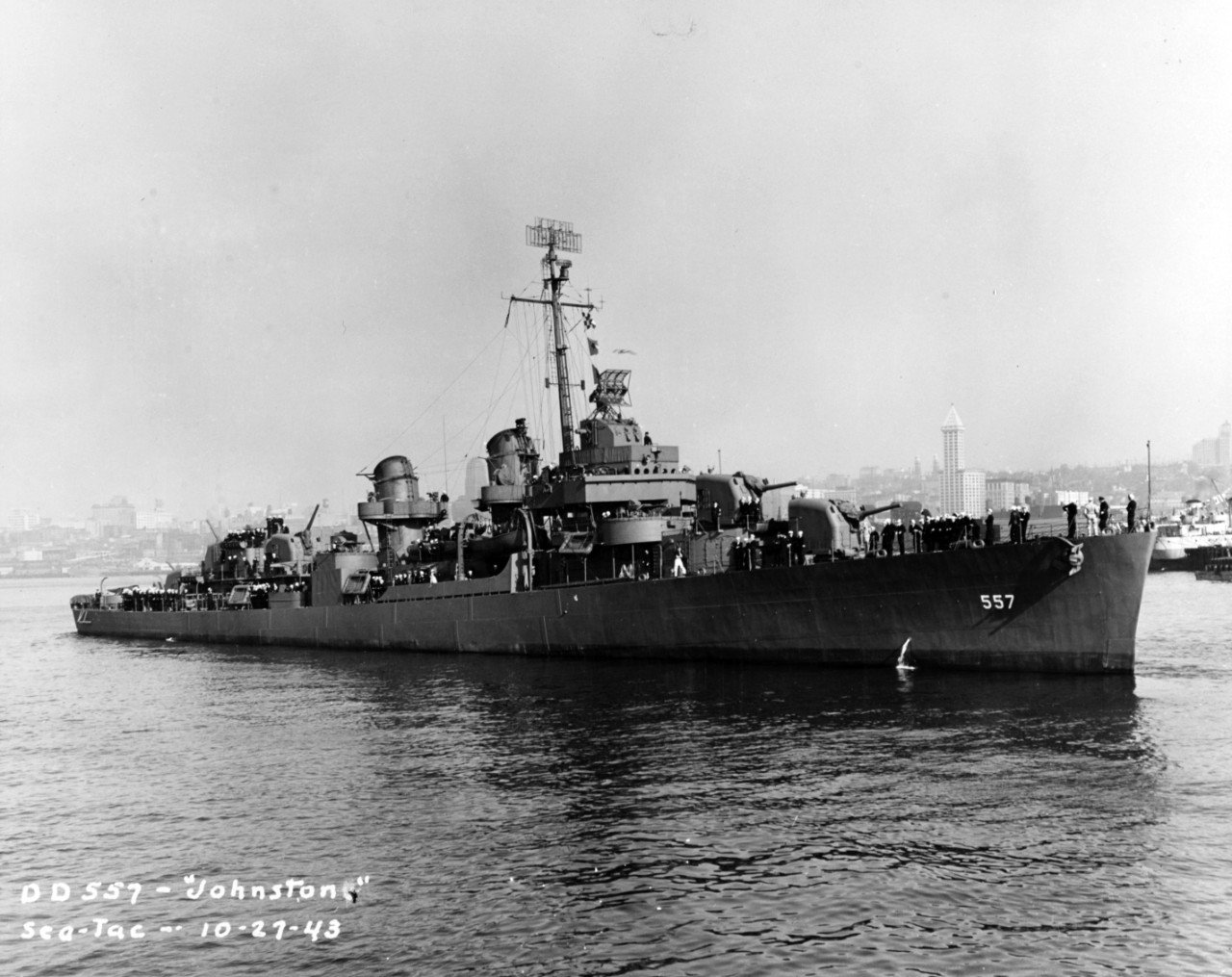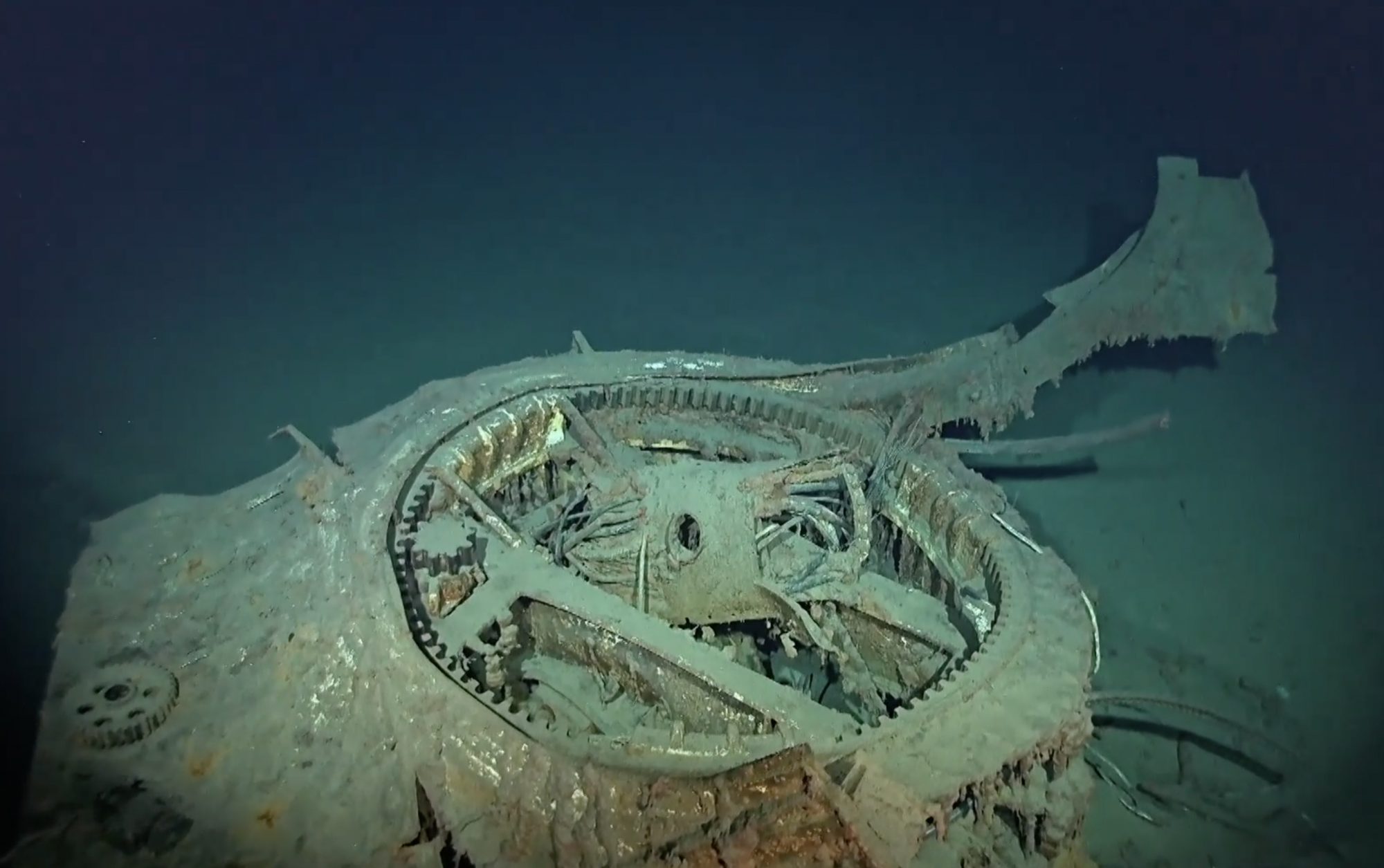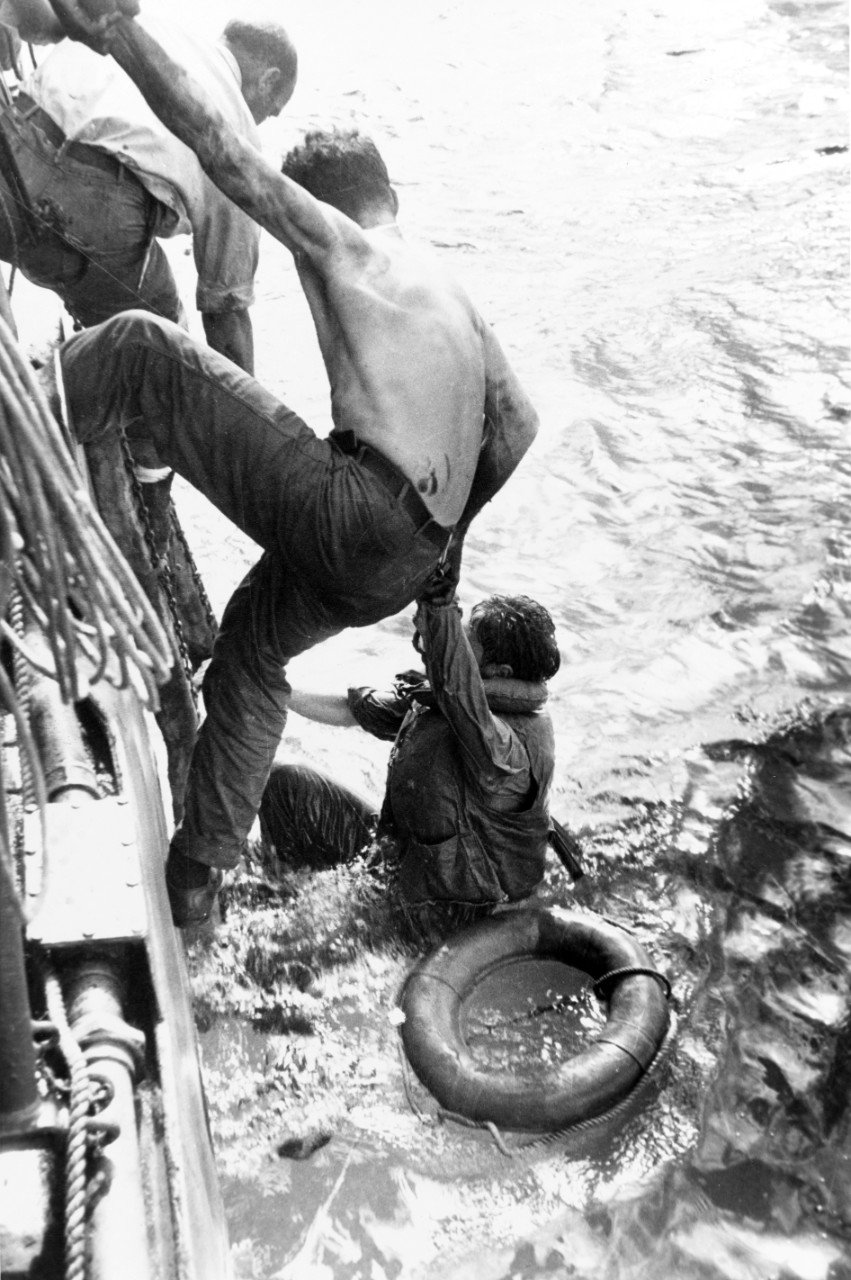Wreckage Found Of Famous World War II Destroyer Whose Commander Was Posthumously Awarded the Medal of Honor

USS Johnston (DD-557) off Seattle or Tacoma, Washington, 27 October 1943. Photo courtesy of the US Navy.
A team of deep diving explorers last week located the final resting place of one of World War II’s most famous lost ships, the USS Johnston, a Fletcher-class destroyer (DD-557) led by one of the Navy’s most legendary fighting commanders.
A team of explorers from the undersea technology company Caladan Oceanic confirmed the identity of the scattered wreckage last week deep in the Philippine Sea along a cliff face at 21,180 feet, or 4 miles, below the surface. The site of the war relic was first discovered in 2019, but the vessel couldn’t be positively identified. The expedition’s leader, entrepreneur and former US Navy officer Victor Vescovo, rode in a submersible to capture video of the ship’s hull number — 557 — confirming the identity of the ship that famously fought to the end 76 years ago during the Battle off Samar.
At the helm of the Johnston was Ernest E. Evans, who was posthumously awarded the Medal of Honor for his actions in command on Oct. 25, 1944. He was the first Native American sailor to be awarded the medal.
Just completed the deepest wreck dive in history, to find the main wreckage of the destroyer USS Johnston. We located the front 2/3 of the ship, upright and intact, at a depth of 6456 meters. Three of us across two dives surveyed the vessel and gave respects to her brave crew. pic.twitter.com/N1AuzHIi0b
— Victor Vescovo (@VictorVescovo) April 1, 2021
Evans had beaten all the odds. As a Native American with Cherokee and Creek blood, he overcame harsh prejudices during his childhood in Pawnee, Oklahoma. His aspirations to become a Marine officer were never realized, and without political connections, he was turned down at the US Naval Academy. Instead, he enlisted in the Navy, reapplied to Annapolis through a fleet competition, and won an appointment to the class of 1931.
In the first two years of World War II, he served on and then commanded the USS Alden, a destroyer, before being assigned to outfit and launch a new destroyer, the USS Johnston, which was being built in Washington.
“This is going to be a fighting ship,” Evans told his crew on Oct. 27, 1943, during the ceremony of the ship’s commissioning. “I intend to go in harm’s way, and anyone who doesn’t want to go along had better get off right now.”
Nobody did.

His aggressiveness shined during one engagement in May 1944 when he was awarded the Bronze Star with combat “V” device for skillful maneuvers against a Japanese submarine. Evans’ tactics and precise depth-charge attack overwhelmed the submarine.
But what Evans is most celebrated for is his heroism while facing four Japanese battleships, including super-battleship Yamato, eight cruisers, and 11 destroyers. The Johnston was assigned to a small convoy called Task Unit 77.4.3, or “Taffy 3.” The lightly armed convoy was composed of destroyers, destroyer escorts, and so-called escort carriers, flat-topped ships half the size of a regular aircraft carrier. The convoy was assigned to protect Gen. Douglas MacArthur’s Philippine landing force at Leyte Bay.
As the day dawned, the Johnston spotted the largest, most heavily armed elements of the Japanese fleet just miles away, closing in on the otherwise undefended landing force. With huge naval guns and airpower, the Japanese would be able to bombard MacArthur’s troops. Only Taffy 3 stood in their way. In broad daylight, Evans ordered the Johnston to break formation and zigzag 2,500 yards to lay a smoke screen to hide the American escort carriers from the Japanese gunners.

“Even as we began laying smoke, the Japanese started lobbing shells at us, and the Johnston had to zigzag between the splashes,” recalled gunnery officer Ensign Robert C. Hagen. “We were the first destroyer to make smoke, the first to start firing, the first to launch a torpedo attack.”
Evans then charged to within 10,000 yards of the Japanese ships, releasing a spread of 10 torpedoes and 200 rounds that devastated the Japanese heavy cruiser Kumano. In the melee, the Johnston was struck by Japanese fire and Evans was seriously wounded.
“It was like a puppy being smacked by a truck,” Hagen said. “The hits resulted in the loss of all power to the steering engine, all power to the three 5-inch guns in the after part of the ship, and rendered our gyro compass useless.”
A rain squall provided the necessary concealment to repair battle-essential equipment. And instead of fleeing to regroup, Evans launched a second attack, firing 30 rounds into a 30,000-ton Japanese battleship. As the battle progressed, Evans realized the escort carrier Gambier Bay (CVE-73) was taking enemy fire from an enemy heavy cruiser, and he gave the order to “commence firing on that cruiser, draw her fire on us and away from Gambier Bay.”

When Evans had depleted his armament to zero torpedoes and only a limited amount of ammunition left in his guns, he challenged Japanese warships, one by one, and all turned away to escape, believing they had stumbled onto a much larger force than Taffy 3. His attempt at a bluff momentarily worked, but eventually the numerical superiority of the Japanese overwhelmed the Johnston. The Johnston began to sink, and Evans ordered his crew to abandon ship.
“The skipper was a fighting man from the soles of his broad feet to the ends of his straight black hair,” Hagen recalled. “He was an Oklahoman and proud of the Indian blood he had in him. We called him — though not to his face — ‘the Chief.’ The Johnston was a fighting ship, but he was the heart and soul of her.”
Of Johnston’s 327 sailors, 141 survived. Evans had made it onto a life raft when the Johnston sank, but succumbed to his injuries and was never seen again. The ship received six battle stars for service in World War II and was awarded the Presidential Unit Citation.
Last week, the Johnston’s remains were identified in its final resting place. At the end of the expedition, the Caladan Oceanic team sounded the ship’s whistle and laid a wreath in honor of those lost in the battle.
“In some ways we have come full circle,” Vescovo said. “The Johnston and our own ship were built in the same shipyard, and both served in the US Navy. As a US Navy officer, I’m proud to have helped bring clarity and closure to the Johnston, its crew, and the families of those who fell there.”

Matt Fratus is a history staff writer for Coffee or Die. He prides himself on uncovering the most fascinating tales of history by sharing them through any means of engaging storytelling. He writes for his micro-blog @LateNightHistory on Instagram, where he shares the story behind the image. He is also the host of the Late Night History podcast. When not writing about history, Matt enjoys volunteering for One More Wave and rooting for Boston sports teams.
BRCC and Bad Moon Print Press team up for an exclusive, limited-edition T-shirt design!
BRCC partners with Team Room Design for an exclusive T-shirt release!
Thirty Seconds Out has partnered with BRCC for an exclusive shirt design invoking the God of Winter.
Lucas O'Hara of Grizzly Forge has teamed up with BRCC for a badass, exclusive Shirt Club T-shirt design featuring his most popular knife and tiomahawk.
Coffee or Die sits down with one of the graphic designers behind Black Rifle Coffee's signature look and vibe.
Biden will award the Medal of Honor to a Vietnam War Army helicopter pilot who risked his life to save a reconnaissance team from almost certain death.
Ever wonder how much Jack Mandaville would f*ck sh*t up if he went back in time? The American Revolution didn't even see him coming.
A nearly 200-year-old West Point time capsule that at first appeared to yield little more than dust contains hidden treasure, the US Military Academy said.












